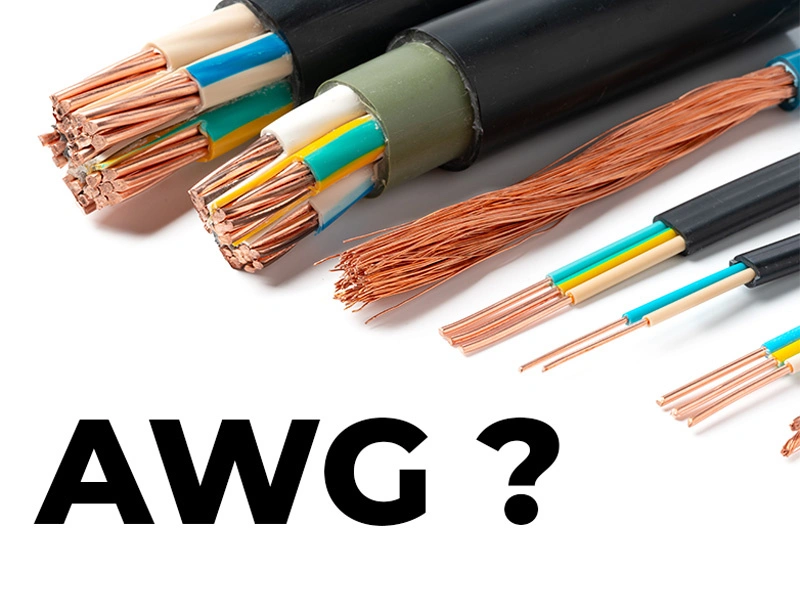AWG (American Wire Gauge) is an international measurement standard used to determine the diameter and cross-sectional area of electrical conductors, not the name of a type of electrical conductor. The special point is the inverse relationship: the larger the AWG number, the smaller the wire cross-sectional area. The reason is that AWG represents the number of times the wire is drawn through dies to reduce diameter from the original size. Understanding AWG correctly helps you:
- Choose the correct wire cross-sectional area for necessary current carrying capacity
- Avoid incidents due to overload or voltage drop
- Optimize costs by not choosing unnecessarily oversized wire
- Ensure electrical safety for the entire system
Ngoc Lan Cable, with many years of experience in manufacturing low voltage electrical cables and medium voltage electrical cables, will explain to you from basic definitions to detailed AWG conversion tables and practical applications.

1. Understanding the true nature of what AWG really is?
1.1. What is the AWG concept?
AWG (American Wire Gauge) is an index for measuring the diameter of electrical conductors according to American standards, which has been used since 1857. This standard is detailed in ASTM B258 and is widely recognized in the global electrical industry.
1.2. Operating principle of AWG
The AWG index in modern electrical engineering is still based on the traditional wire manufacturing principle. The wire drawing process is performed as follows:
Starting from a metal wire strand with a standard wire diameter (typically 0.46 inch). During the manufacturing process, the wire strand is drawn through multiple consecutive dies, and each time it passes through a die, the diameter decreases according to a fixed ratio. This number of times drawn through dies has become the AWG index that we use today to classify wire sizes.
Thus, the higher the AWG index means the wire has been drawn through more dies. Therefore, the AWG standard has the principle of being inversely proportional to the conductor diameter.
1.3.Practical example of AWG index
The inverse relationship of AWG is the number of times the wire must pass through drawing dies – the more times drawn, the thinner the wire. Let's look at common AWG sizes of copper wire below to better understand this principle:
- 12 AWG wire: Diameter 2.05mm, cross-sectional area 3.31mm²
- 14 AWG wire: Diameter 1.63mm, cross-sectional area 2.08mm²
- 16 AWG wire: Diameter 1.29mm, cross-sectional area 1.31mm²
- 18 AWG wire: Diameter 1.02mm, cross-sectional area 0.82mm²
Các thông số này tuân thủ nghiêm ngặt IEC 60228 để đảm bảo tính thống nhất toàn cầu và khả năng tương thích giữa các nhà sản xuất.
Hiểu được bản chất này giúp kỹ sư và kỹ thuật viên không chỉ tra bảng mà còn có thể ước tính nhanh kích thước dây phù hợp cho từng ứng dụng cụ thể.
2. Why is the AWG index so important?
Selecting the correct conductor cross-sectional area according to AWG standards not only affects performance but also determines the electrical safety of the entire system. Mistakes in AWG selection can lead to unexpected incidents.
2.1. Direct impact on current carrying capacity
Current carrying capacity (ampacity) is the most important parameter determined by wire cross-sectional area. When electric current exceeds the allowable limit, the wire will heat up.
Standard current carrying capacity in normal environment (30°C):
- 10 AWG wire: Maximum ampacity 30A
- 12 AWG wire: Maximum ampacity 20A
- 14 AWG wire: Maximum ampacity 15A
- 16 AWG wire: Maximum ampacity 13A
Consequences of wrong selection:
- Overheating: Damages the insulation layer
- Fire and explosion risk: Especially dangerous in construction projects
- Reduced lifespan: Equipment and electrical systems are damaged
2.2. Impact on voltage drop phenomenon
Wire with large AWG (small cross-sectional area) has high resistance, causing significant voltage drop over long distances.
2.3. Impact on electrical signal quality
In signal wire and control applications, AWG also affects important electronic parameters, especially resistance. Resistance increases with AWG index, causing signal loss. Therefore, in audio systems, speaker wire needs low AWG to reduce signal loss.
Understanding these impacts clearly helps you make accurate decisions in selecting the appropriate wire cross-sectional area for each specific application.
3. AWG to mm and mm² conversion table (updated 2024)
The AWG to mm² conversion table is an indispensable tool for converting between American standards and the international metric system. Accurate reference ensures compatibility and safety in all electrical projects.
3.1. Detailed reference table for AWG to mm and mm²
International standard conversion table based on ASTM B258 and IEC 60228:
| AWG | Diameter (mm) | Cross-sectional area (mm²) | Current carrying capacity (A) |
|---|---|---|---|
| 4/0 | 11.68 | 107.2 | 230 |
| 3/0 | 10.40 | 85.0 | 200 |
| 2/0 | 9.27 | 67.4 | 175 |
| 1/0 | 8.25 | 53.5 | 150 |
| 1 | 7.35 | 42.4 | 130 |
| 2 | 6.54 | 33.6 | 115 |
| 4 | 5.19 | 21.2 | 85 |
| 6 | 4.11 | 13.3 | 65 |
| 8 | 3.26 | 8.37 | 50 |
| 10 | 2.59 | 5.26 | 30 |
| 12 | 2.05 | 3.31 | 20 |
| 14 | 1.63 | 2.08 | 15 |
| 16 | 1.29 | 1.31 | 13 |
| 18 | 1.02 | 0.82 | 10 |
| 20 | 0.81 | 0.52 | 5 |
| 22 | 0.64 | 0.33 | 3 |
| 24 | 0.51 | 0.20 | 2 |
3.2. How to use the reference table effectively
Below is the procedure for using the AWG reference table, helping you easily reference technical specifications in the metric system:
Step 1. Find the AWG number of the wire
The AWG number is usually printed on the wire sheath or can be measured using a specialized AWG gauge or by measuring diameter and converting.
Step 2. Reference in the table
- Find the number in the AWG column corresponding to the wire you are using.
- Reference related information such as diameter (mm or inch), conductor cross-sectional area (mm²), or current carrying capacity (A).
Step 3. Understand the specifications
- Lower AWG: Larger wire diameter, larger cross-sectional area, and higher current carrying capacity.
- Higher AWG: Smaller wire diameter, smaller cross-sectional area, and lower current carrying capacity.
Ngoc Lan Cable recommends always choosing a wire size one level larger than the minimum calculation to ensure safety and future contingency.
4. Comparison between AWG and TCVN standards
Understanding the differences between AWG and TCVN standards clearly helps Vietnamese engineers effectively apply international technical specifications to local practice.
4.1. Basic differences between the two wire standards
AWG Standard (USA):
- Based on conductor diameter
- Uses reverse numbering system (large number = small wire)
- Popular in electronics and audio equipment
- Mainly applied in North America and some Asian countries
TCVN/IEC Standard (International):
- Based directly on mm² cross-sectional area
- Forward numbering system (large number = large cross-sectional area)
- Popular in electrical industry and construction
- Widely used in Vietnam and Europe
4.2. AWG comparison table with TCVN cross-sectional area
Detailed comparison of common sizes:
| AWG | Cross-sectional area (mm²) | Nearest TCVN | Difference |
|---|---|---|---|
| 12 | 3.31 | 4.0 | +21% |
| 14 | 2.08 | 2.5 | +20% |
| 16 | 1.31 | 1.5 | +15% |
| 18 | 0.82 | 1.0 | +22% |
| 20 | 0.52 | 0.75 | +44% |
| 22 | 0.33 | 0.5 | +52% |
4.3. Notes when converting AWG to TCVN in practice
Principles for selecting TCVN cross-sectional area:
- Always choose the nearest larger TCVN standard cross-sectional area
- Do not convert backward from TCVN to smaller AWG
- Consider temperature coefficient and installation environment
Practical conversion examples:
- Equipment requires 18 AWG → Choose 1.0mm² TCVN wire
- System needs 16 AWG → Use 1.5mm² TCVN
- Application for 14 AWG → Apply 2.5mm² TCVN
Strict adherence to these principles when comparing AWG wire and mm² wire ensures safety and compliance with local standards.
5. Frequently asked questions about AWG wire (FAQ)?
Common questions about AWG wire encountered in practice help clarify ambiguous points and avoid common mistakes.
5.1. Is AWG wire fire-resistant?
No, AWG is a size index, and fire-resistant characteristics depend on the sheath material. Electric cables commonly use LSZH (Low Smoke Zero Halogen) or FR-PVC materials for fire-resistant sheaths.
5.2. Between 16 AWG and 18 AWG wire, which is better?
Which wire is better depends on the application or usage requirements. 16 AWG wire has a larger cross-sectional area (1.31mm² compared to 0.82mm²), better current carrying capacity but is more expensive than 18 AWG wire.
5.3. What is "gauge" wire?
Gauge wire (or gauge index) is a short way of saying AWG index.
5.4 What types of AWG wire are there?
The AWG index applies to many different types of conductors in the electrical and electronics industry such as:
- Residential and industrial electric building wires
- Signal and control cables
- Network and telecommunication cables
- Small electronic wires and household electrical equipment
6. Conclusion
What is AWG wire? – This question has been comprehensively answered through in-depth analysis of the most important measurement standard in the electrical industry. Understanding AWG correctly not only helps select appropriate wire cross-sectional area but also ensures electrical safety for the entire system.
Key points to remember:
- Nature of AWG:
- American Wire Gauge is a measurement standard, not a wire type
- Inverse relationship: large AWG number = small wire diameter
- Principle based on traditional wire drawing process
- AWG index reference tools:
- Detailed AWG conversion table according to international standards
- Comparison guide with TCVN for applications in Vietnam
- Answers to frequently asked questions in practice
Are you looking for consultation on selecting appropriate electric cables for your project? Contact Ngoc Lan Cable for in-depth technical support and receive the best quotation for high-quality electric cable products.

 VN
VN